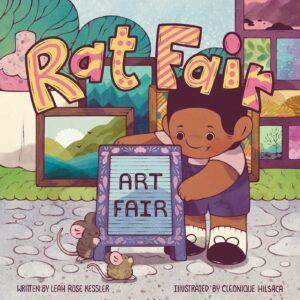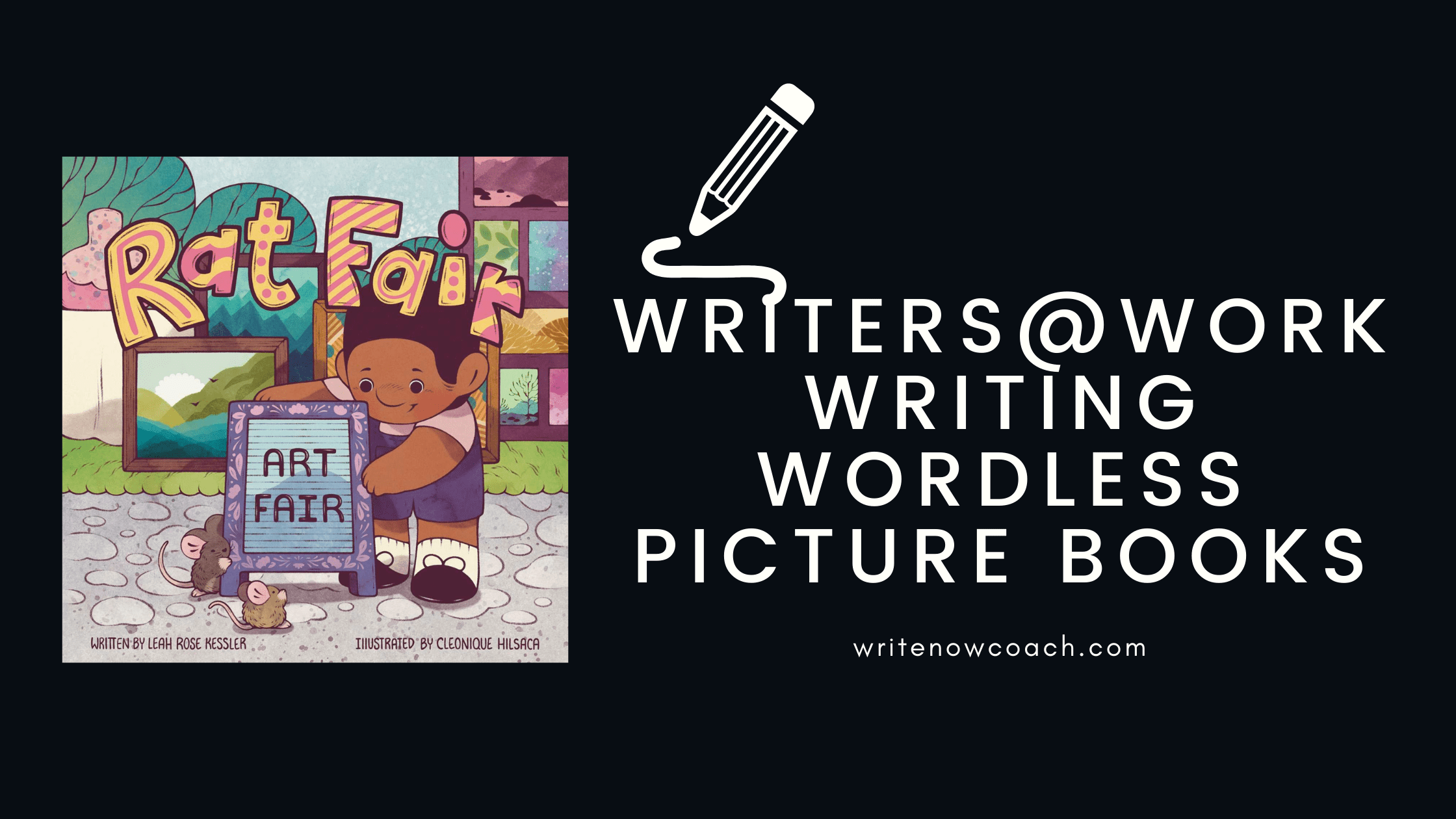Writers@Work: Writing a Wordless Picture Book
June 22, 2021
Note From Rochelle
Dear Writers,
How do you handle distraction?
 My kids are home from college, working part time jobs. My home office feels like the traffic hub in a busy city. As a result, I feel distracted. One tool helps me: pausing. When I get interrupted, I tend to have difficulty refocusing. Instead, I want to shift my focus to something new, usually social media.
My kids are home from college, working part time jobs. My home office feels like the traffic hub in a busy city. As a result, I feel distracted. One tool helps me: pausing. When I get interrupted, I tend to have difficulty refocusing. Instead, I want to shift my focus to something new, usually social media.
My solution? I’ve found it helpful to simply PAUSE and say to myself, “Is this what you want to do?” That simple action helps me to get back on track and finish my work.
Today’s tip is from my fellow debut group member Leah Rose Kessler. (You can read about our debut group here: https://www.newbooksforkids.com/). She talks about how she sold a wordless picture book! Rat Fair debuts next Tuesday, June 29.
Enjoy!
Rochelle
Writers@Work: How to Write a Wordless Picture Book
An Interview with Leah Kessler
Welcome, Leah. Can you tell us about your new book, Rat Fair?
 Hello, and thank you for having me on the blog! I’m so excited to share Rat Fair with you. It was inspired by my habit of playing with words combined with the fact that I grew up in (and now live near) a town that holds a giant art fair every summer. Once I’d turned the words on an Art Fair sign into “Rat Fair” in my head and began imagining what a rat fair might actually be like, I couldn’t stop thinking about it until I wrote it down, and here we are!
Hello, and thank you for having me on the blog! I’m so excited to share Rat Fair with you. It was inspired by my habit of playing with words combined with the fact that I grew up in (and now live near) a town that holds a giant art fair every summer. Once I’d turned the words on an Art Fair sign into “Rat Fair” in my head and began imagining what a rat fair might actually be like, I couldn’t stop thinking about it until I wrote it down, and here we are!
Rat Fair is a nearly wordless picture book about a very talented group of rats who find letters fallen from an Art Fair sign, put the sign back together so it spells Rat Fair and then get down to business creating their own fair. They meet some setbacks and have to start over again, and it eventually becomes apparent that they might do well to trust the human child who’s been hanging around on the sidelines and wants to help them out. I like to think of it as a story about curiosity, kindness, and perseverance. I also like to think of it as a story about adorable rats who build tiny things.
By nearly wordless, I mean that there is a tiny bit of reading inside the book, but no actual story text. If you’ve read the cover, you’ve read all three words in the book: rat, art, and fair. They appear on signs in a few different places for a grand total of nine words. The fun thing about a wordless story is that you can invite your child or the young students in your classroom to read the book to you for a change!
What was your path to publication like?
I’m unagented, and I had a feeling that a wordless manuscript probably wasn’t my best bet for snagging an agent to represent me for my scintillating prose. With that in mind I went through SCBWI’s The Book with a fine tooth comb and made a list of picture book publishers that were accepting unagented submissions and seemed like they would be a good fit for my manuscript. I submitted to about half of my list of 30 publishers and luckily for me, one of them fell in love with my story! As they say, it just takes one person who feels as strongly about your story as you do.
I, personally, found the process of negotiating my own contract with a publisher very stressful, though I’m sure the general stress of the situation wasn’t helped by this all happening during the spring of 2020, which found me suddenly at home trying to teach my class of 3rd and 4th graders over Zoom. I joined the Author’s Guild so I could take advantage of their legal services and had their lawyers look over my contract for me, which was very helpful.
How do you write and sell a wordless picture book?
The process of writing and pitching Rat Fair was just like writing any other picture book. It started with an idea that turned into a manuscript that went through a few rounds of revision with feedback from my small local critique group, a few trusted online critique partners, and Julie Hedlund’s 12×12 Picture Book Challenge community.
The manuscript itself is more or less a page and a half of illustration notes that tell the story. As with any illustration notes, I was careful to use only the words necessary to convey the essential plot of the story and I left a lot up to the illustrator and editor who worked on the book. For example, there’s a line in the manuscript that says, “A street sweeper passes through, sweeping away the debris on the ground—including everything the rats built for their fair.” I didn’t specify whether it should be a person with a broom or one of those street sweeping vehicles with giant brushes because I felt that decision could really set the tone for the whole book and I wanted the illustrator to be able to make those choices.
The one thing I did that was specific to the nearly wordless nature of my story was that I added a line at the top of my manuscript and in my query that clearly explained the nine words of story text were to be on signs in the illustrations and were indicated by all upper-case letters in the manuscript.
What advice do you have for someone wanting to break into the children’s picture book market?
My advice, hands down, is to find your writing community. That could look like all sorts of things. It could mean joining a professional organization like SCBWI or 12×12. It could mean hooking up with a local critique group or writing partner, attending writing workshops at your local library, taking an online class that encourages participants to interact with each other’s work (which is a great way to learn and also to make connections), and anything else that puts you in contact with other people who are at a variety of stages in their writing careers.

What are you reading now?
I’m one of those people who can’t seem to read just one book at a time. I recently finished See You in the Cosmos, a really terrific contemporary middle grade novel by Jack Cheng, and I’m currently in the middle of the graphic novel version of Sapiens, by Yuval Noah Harari and Tell the Wolves I’m Home by Carol Rifka Brunt, and in the car I’m listening to Down and Across, a YA by Arvin Ahmadi. My current picture book stack is pretty heavy on books about music and books about the moon, as well as a whole slew of new releases now that I’m finally able to go inside my library and raid the New Picture Books shelf. As a writer, reading both in and out of your genre is important and that’s something I don’t seem to have any trouble with at all!
 About the author. Leah Rose Kessler spent much of her childhood up a tree with a stack of books. These days, when she’s not reading or writing, she’s an on-again, off-again elementary school teacher and a lifelong biologist. She lives in Michigan with two humans and two cats, and has a soft spot for scurrying creatures of all shapes and sizes.
About the author. Leah Rose Kessler spent much of her childhood up a tree with a stack of books. These days, when she’s not reading or writing, she’s an on-again, off-again elementary school teacher and a lifelong biologist. She lives in Michigan with two humans and two cats, and has a soft spot for scurrying creatures of all shapes and sizes.
NOTE: The books links lead to the Write Now! Coach bookstore on Bookshop.com. Write Now! Coach receives a small percentage of your purchase, which helps to support this blog. Here’s the bookstore: https://bookshop.org/lists/books-featured-on-the-write-now-coach-blogs










Fantastic interview about such a fascinating genre. Great insights from author Leah Kessler! Thanks for sharing this.
Thank you, Morissa!
Thank you for explaining your creation and querying process. Excited for this book
Thank you Stephanie! I’m glad you enjoyed hearing about it.